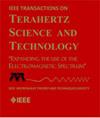基于 MEMS 可重构表面间干扰的高性能 220-290 GHz 微机械波导开关
IF 3.9
2区 工程技术
Q2 ENGINEERING, ELECTRICAL & ELECTRONIC
IEEE Transactions on Terahertz Science and Technology
Pub Date : 2024-01-19
DOI:10.1109/TTHZ.2024.3356184
引用次数: 0
摘要
本文介绍了一种高度集成的新型硅微机械单刀单掷波导开关,它基于两个微机电可重构开关表面(MEMS-RS),利用集成的静电梳状驱动致动器,通过调整两个此类 MEMS-RS 之间的干扰来优化开关性能。开关原型采用轴向对齐的标准 WR-3.4 波导端口,总占地面积为 3 毫米×3.5 毫米×1.2 毫米。在两个标准 WR-3.4 波导法兰之间测得的阻塞(关)状态插入损耗(隔离)和回波损耗分别为 28.5-32.5 dB 和优于 0.7 dB,在 220-290 GHz 频段测得的传播(开)状态插入损耗和回波损耗分别为 0.7-1.2 dB 和优于 17 dB。测量结果与仿真数据非常吻合,意味着分带宽为 27.5%,非常接近全波导带性能。为了进一步研究,还制作了只有一个 MEMS-RS 和没有任何 MEMS-RS 的两种开关电路。单 MEMS-RS 开关在 220 至 274 GHz 范围内的离态隔离度、导通插入损耗和回波损耗分别仅为 11.5 至 12.5 dB、0.8 至 1.3 dB 和优于 12 dB,这清楚地表明了基于干扰的双 MEMS-RS 开关设计的性能大幅提高。此外,对纯波导参考结构的测量结果表明,波导部分只占双 MEMS-RS 开关测量到的通态插入损耗的 0.2-0.5 dB,其余部分是由于在波导内引入了 MEMS-RS。本文章由计算机程序翻译,如有差异,请以英文原文为准。
A High-Performance 220–290 GHz Micromachined Waveguide Switch Based on Interference Between MEMS Reconfigurable Surfaces
This article presents a highly integrated novel silicon micromachined single-pole-single-throw waveguide switch based on two microelectromechanically reconfigurable switching surfaces (MEMS-RSs), which allows optimizing the switching performance by tuning the interference between the two such MEMS-RSs utilizing integrated electrostatic comb-drive actuators. The switch prototype is implemented with axially aligned standard WR-3.4 waveguide ports with a total footprint of 3 mm×3.5 mm×1.2 mm. The measured blocking (
off
) state insertion loss (isolation) and return loss, measured between two standard WR-3.4 waveguide flanges, are 28.5–32.5 dB and better than 0.7 dB, and the propagating (
on
) state insertion and return losses are 0.7–1.2 dB and better than 17 dB in the 220–290 GHz frequency band, respectively. The measured results were in excellent agreement with the simulation data, implying 27.5% fractional bandwidth, which is very close to a full waveguide band performance. For further investigations, two variants of the switching circuit with only a single MEMS-RS and without any MEMS-RSs have also been fabricated. The single MEMS-RS switch achieved the
off
-state isolation,
on
-state insertion loss, and return loss of only 11.5–12.5 dB, 0.8–1.3 dB, and better than 12 dB from 220 to 274 GHz, respectively, which clearly indicates the drastic performance improvement of the interference-based double MEMS-RS switch design. Moreover, measurement of the waveguide-only reference structure showed that the waveguide section alone attributed to 0.2–0.5 dB of the measured
on
-state insertion loss of the double MEMS-RS switch, and the rest is due to the introduction of the MEMS-RSs inside the waveguides.
求助全文
通过发布文献求助,成功后即可免费获取论文全文。
去求助
来源期刊

IEEE Transactions on Terahertz Science and Technology
ENGINEERING, ELECTRICAL & ELECTRONIC-OPTICS
CiteScore
7.10
自引率
9.40%
发文量
102
期刊介绍:
IEEE Transactions on Terahertz Science and Technology focuses on original research on Terahertz theory, techniques, and applications as they relate to components, devices, circuits, and systems involving the generation, transmission, and detection of Terahertz waves.
 求助内容:
求助内容: 应助结果提醒方式:
应助结果提醒方式:


